Illustrations of German tram infrastructure and signals – Part 1
Evening all!
On a photo round I went on today, I devoted some of the time to capturing a few examples of typical tram signals, which I'd also like to follow up with additional sets of examples at later dates as I get to gather them.
But I won't let you jump in at the deep end and would thus like to first provide a few introductory paragraphs!
German trams most commonly run under what could be called visual operating conditions, meaning that cars proceed on sight from one signal to the next, and that no train protection systems as would be present on railways are available. Such systems generally are installed only on grade-separated routes of various light rail networks throughout the country.
That, of course, means drivers must generally observe regular traffic rules on street-bound routes, and trams must be outfitted with the same basic arrangement of headlights, brake lights and turn indicators as automobiles. Obviously, trams must, given their weight, also be outfitted with highly effective brakes to be able to operate safely under these conditions and in the middle of automobiles. This is why they are generally outfitted with magnetic track brakes to allow for very short emergency stopping distances.
Generally, tram and other light rail systems are subject to the regulations laid out in what is colloquially called "BOStrab" in German, which is shorthand for "Bau- und Betriebsordnung für Straßenbahnen" and best translated as "Tram Construction and Operating Ordinance." This is a set of regulations completely separate from the "Eisenbahn-Bau- und Betriebsordnung" (Railway Construction and Operating Ordinance), abbreviated "EBO" and applicable to all "heavy rail" systems in Germany.
Most commonly, rail vehicles comply to only EBO or only BOStrab but not both at the same time. Exceptions to that rule can be found, for example, on the suburban network in the Karlsruhe area or on the Saarbahn network, either of which constitutes a tram-train system. Basically, these tram-trains must therefore, among other parameters, meet railway crashworthiness and impact resistance norms, and be outfitted with wheelsets suitably profiled for both railway and tram track geometries.
Now, as I indicated in the title, this little series of postings will also address other aspects of tram infrastructure where appropriate, which is why I might just begin with this photo...
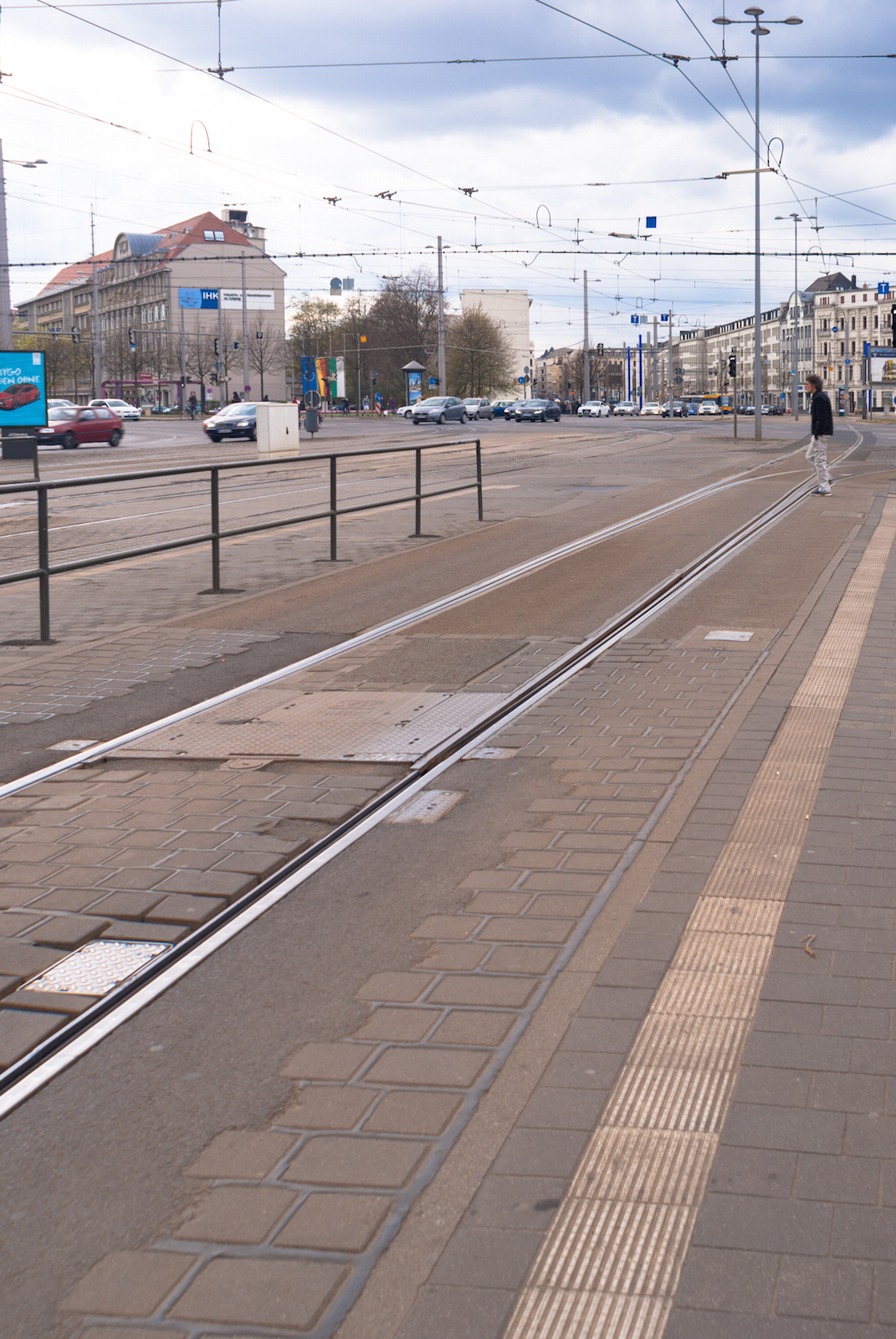
Paved-in track is generally built with grooved rails while grade-separated tracks can be built with either Vignoles or grooved rails. On paved-in routes, points therefore differ a bit from regular points, which I'll get back to in a few moments.
In order to increase route capacity at intersections or other key locations, it is now quite common to provide what is commonly called "sorting points." Technically, these are, basically, very long points with the point blades being placed far ahead of the diverging track. Assuming two cars following each other but working different lines, this allows for either car to be properly routed in advance of passing an intersection in order to maximise throughput for each signal cycle.
Taken at the Goerdelerring intersection here in Leipzig, the straight track proceeds into Jahnallee and is used by Lines 3, 4, 7 and 15, while the diverging track turns onto Pfaffendorfer Straße and is for Line 12. Similar sorting points, some even longer, also exist in other locations in the city but some can be photographed safely only aboard trams.
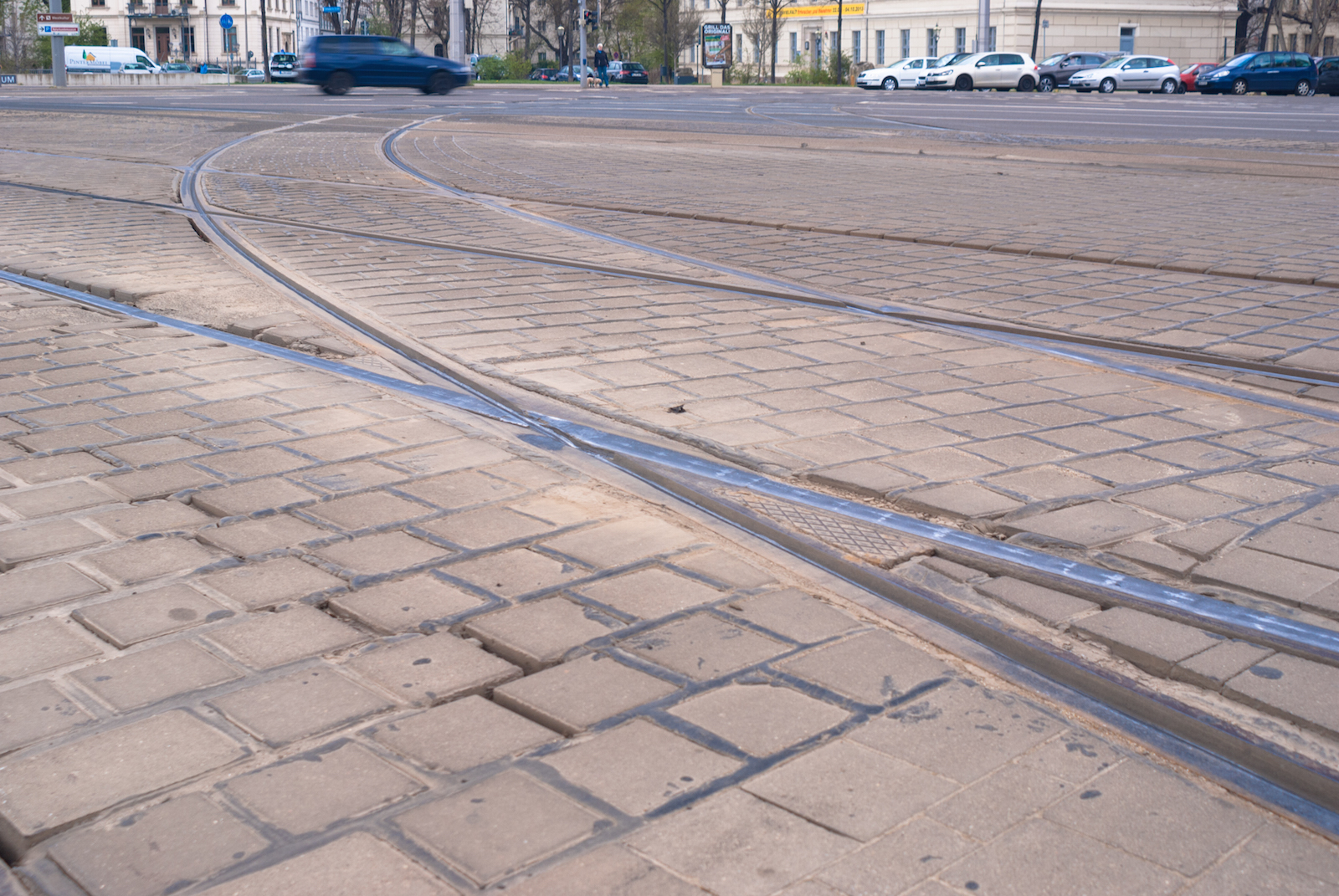
While no sensible alternative to grooved rails exists for paved-in track, this type of rail does, technically, entail an increased risk of stones, snow, ice or other materials getting stuck in the grooves. On points in particular, this could result in derailments, so in order to counter this risk, the rail elements utilised for points are fabricated with much shallower grooves.
As you can see in the above photo, also taken at Goerdelerring, this configuration is most prominently evident at the common crossings. Looking closely, you can also spot the stock rail grooves varying in depth in between the common crossings, where they are most shallow. This also means that effectively, the common crossings are flange bearing, so that the wheel flanges rather than the treads carry the car weight. I understand this also has the additional effect of extending the common crossings' lives.
*************
Changing the topic back to signalling, one remark which I think I should make up front is that while the Tram Construction and Operating Ordinance does outline a common framework of guidelines as to the purpose and appearance of tram signals which is valid throughout Germany, the Technical Supervision Authorities ("Technische Aufsichtsbehörden", TAB) in the individual states as well as the operating companies themselves are at liberty to request and implement adaptations to suit specific requirements posed by local conditions which the general BOStrab framework could not cover.
Such individual adaptations which are specific for one particular tram system are outlined in local application guidelines usually designated "DFStrab", spelt out as "Dienstordnung für den Fahrbetrieb – Straßenbahn" and suitably translated as "Operational Tram Service Regulation."
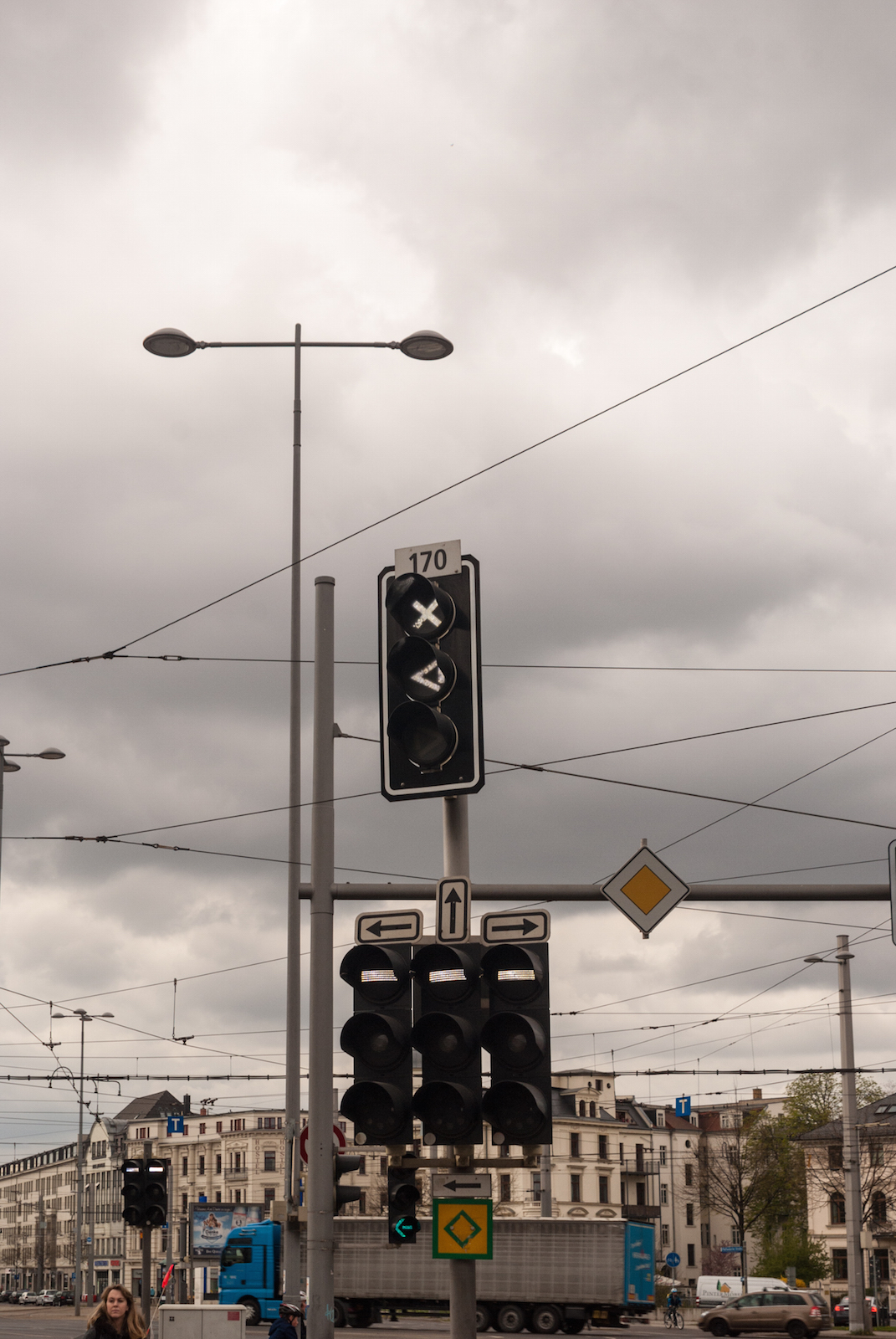
While, to my knowledge, tram signals outside of Germany tend to look fundamentally similar, I would like to explain them in a bit more detail in any case. This example of a multi-aspect, multi-route signalling cluster is, again, at the Goerdelerring intersection.
Fundamentally, tram signals should be understood largely as pure route signals, as opposed to German railway signals which generally imply specific running speed information as well.
These route signals are generally referred to as "F signals", spelt out as "Fahrsignale" and extended to the individual aspects.
On multi-route junctions such as this one, there is generally one signal screen for each route which can be set from this location, and indeed relevant only to that individual route.
In this example, the three screens for each of the three routes which can be set from here all show F 0, "Stop." Do note that the three screens nearer the camera actually can be understood as distant signals for the actual route signals, one of which you can see beyond the lady which happened to be in view here. These route signals also display F 0.
Also take note of the screen set atop the cluster of three "F" signal screens, and lettered to refer to the points from the first photo, 170. This is, essentially, a point indicator, obviously useful to inform drivers whether the proper route for their turn has indeed been set.
As tram points must no longer be set by way of OHLE current sensing contacts (which were disallowed in the mid-1990s), route setting is now commonly performed automatically through induction-based telemetry with transmitter coils on cars and ground-mounted transceiver coils. These transmitters are tied to the Integrated Onboard Information System – "Integriertes Bordinformationssystem" or "IBIS" in German – so that as a driver, you need to enter the line and turn number through a cab terminal for the car to be properly routed for the duration of the shift.
If, for some reason, the proper route was not set automatically, you can manually set points either by way of corresponding keys on the IBIS terminal or control desk while within transmitting distance of the ground-based transceivers – or by way of a simple lever carried in each cab and actually referred to as a "spear" in operating parlance.
As for the point indicator in the present example, the variety used in Leipzig is, actually, an example for how individual operators may implement modifications to the general BOStrab framework. I'll address this in a few moments!
But, first of all, take note of the "X" symbol lit up at the top of the screen. This is the "W 0" aspect indicating that the points are currently locked in position for the next tram to pass it and that none of the following trams can reset the points until they have been cleared.
Now, looking at the first image in this posting, you will notice that the point in question has a straight branch and a right hand branch. However, the indicator in this example is equipped with aspects for left and right hand branch.
While BOStrab does specify an aspect for the straight branch, LVB have chosen to normally utilise only the aspects for left and right on point indicators, so that in this example, the "left" branch actually refers to the straight route.
The standard aspect for the straight route would appear as an upward pointing arrowhead.
It is also important to keep in mind that there are actually two variations for each of the point indicator aspects: Without the straight "bar" at the open end of the arrowhead, the point is indicated to not be mechanically locked in position, imposing a 15 kph speed limit.
When the bar does display, the point is mechanically locked, allowing regular running speed.
This means there are the following point aspects as per BOStrab:
W 1 – straight, not locked
W 2 – right, not locked
W 3 – left, not locked
W 11 – straight, locked
W 12 – right, locked
W 13 – left, locked
*********
As I mentioned before, the triple route signal cluster in the foreground functions as advance indicators for the upcoming route signals nearer the intersection. Thus, take note of the following photo:
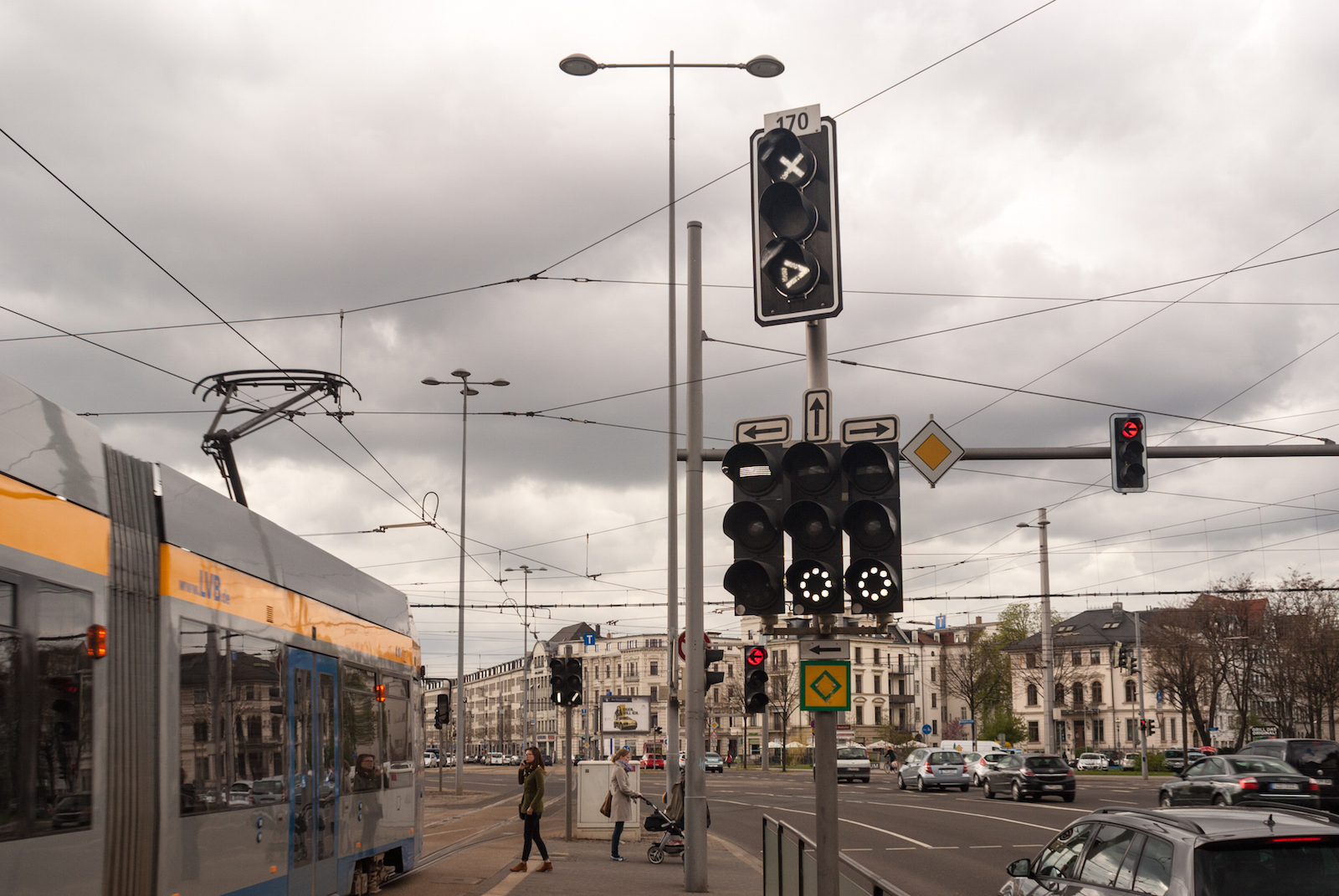
Here, a Line 12 working is leaving to turn right onto Pfaffendorfer Straße.
Obviously, tram signals must, where present, be interlocked with traffic lights for road users, so that in this example, the road signals are set such that the route would be clear for trams leaving straight ahead into Jahnallee and to the right. Correspondingly, the foreground signals show "A 2b" at the bottom for the straight and right routes, with A 2b being an "Order to depart."
Likewise, the route signals beyond the pedestrians show "F 1, Proceed Straight" for the straight branch, and "F 2, Proceed Right" for the right hand branch. The point indicator shows "W 12" plus "W 0" to indicate the point is set and locked for the right hand branch.

Meanwhile, in this view, the advance signal for the straight route shows A 2b corresponding with F 1 on the route signal, while the advance signal for the right branch shows the combination of F 0 and F 4.
The standard definition for F 4 is given as "Expect Stop." By the standard definition, the aspect also does not light up simultaneously with any other F aspect, but many tram operators – if not the majority of them – have redefined this aspect to function similarly to the yellow light in road traffic lights. So, in Leipzig, it is possible to display the combinations of F 0 and F 4 indicating "Expect Proceed", while "Expect Stop" is signalled by displaying F 4 only on the relevant screen.
In total, there are six F aspects:
F 0 – horizontal bar: Stop
F 1 – vertical bar: Proceed Straight
F 2 – right diagonal bar: Proceed Right
F 3 – left diagonal bar: Proceed Left
F 4 – single dot: Expect Proceed for given direction
F 5 – triangle pointing downward: Proceed Permissive (Observe Right of Way at location)
******
Having spoken about points earlier, let us briefly return to this topic and have a look at this signal board:

I am, of course, referring to the black and white plate attached to the OHLE, seen right above the rear end of 1331.
While tram points are frequently designed as variable points to allow running through from the trailing end regardless of position, points which are not thus equipped – such as in this example at the Augustusplatz intersection – are highlighted with a "W 14" board, set to be visible only from the trailing end. So, W 14 indicates "No Trailing Point Movements."
************
Given the narrow curve radii commonly found on tram routes, certain locations may call for special measures to reduce wear and noise. Typically, this would be in the shape of curve greasers, highlighted by the following signal plate:
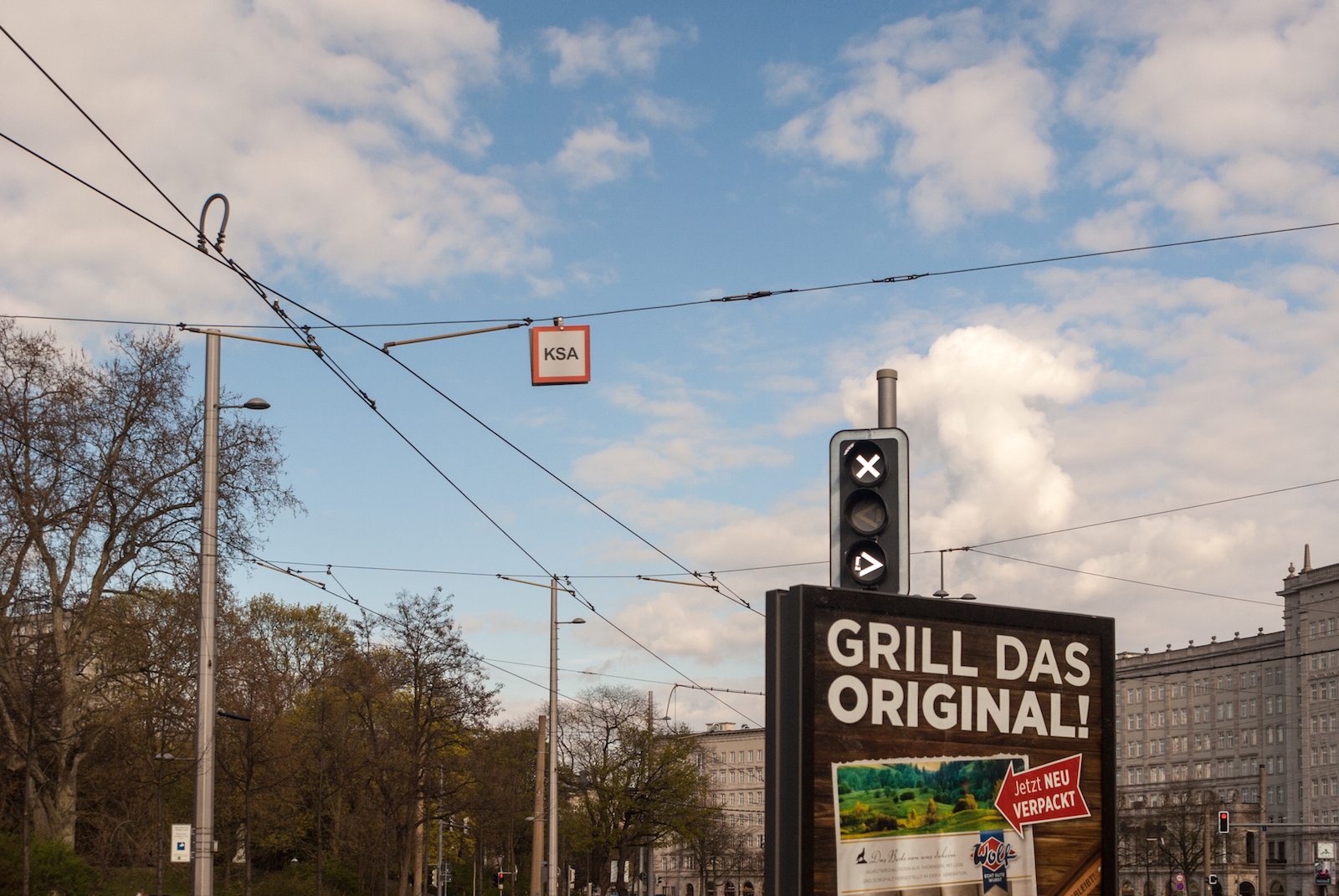

…spelt out as "Kurvenschmieranlage." This example would be located at the eastern end of the Wilhelm-Leuschner-Platz stop...
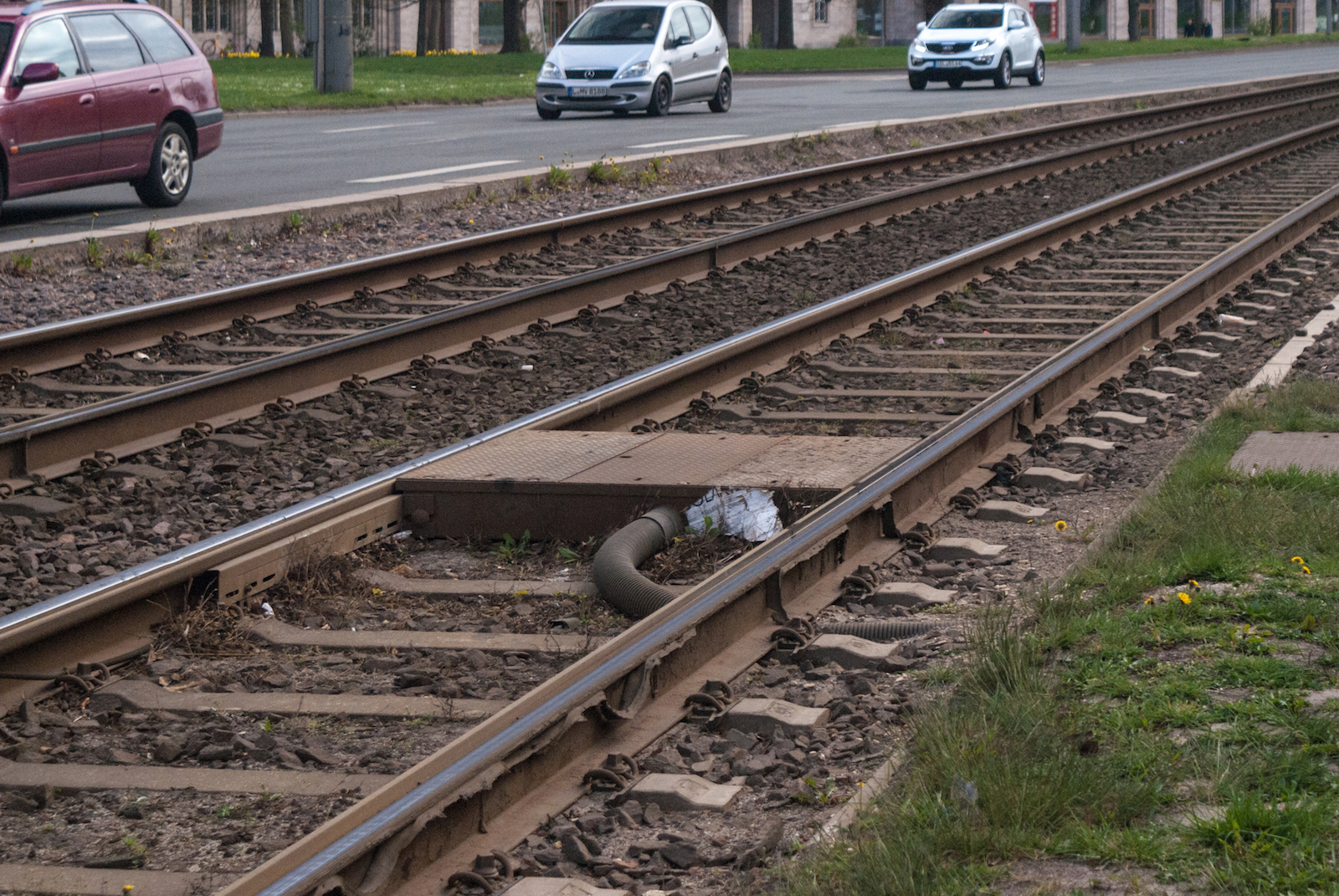
…while another curve greaser, seen here, is located at the beginning of the grade-separated section just south of Augustusplatz.
And that would be it for this time. Thanks for reading!
(April 19: Edited for inexplicably jumbled formatting)



4 Comments
Recommended Comments
Create an account or sign in to comment
You need to be a member in order to leave a comment
Create an account
Sign up for a new account in our community. It's easy!
Register a new accountSign in
Already have an account? Sign in here.
Sign In Now